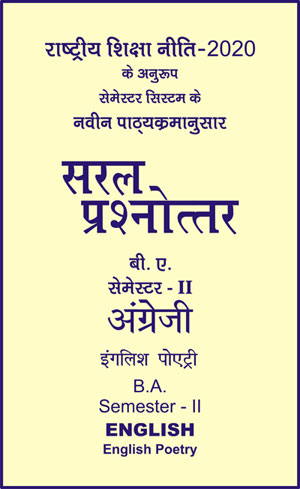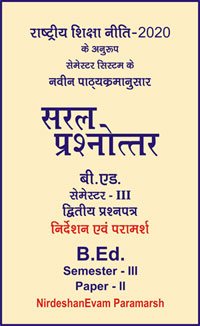|
बी ए - एम ए >> बीए सेमेस्टर-2 - अंग्रेजी - इंगलिश पोएट्री बीए सेमेस्टर-2 - अंग्रेजी - इंगलिश पोएट्रीसरल प्रश्नोत्तर समूह
|
|
|||||||
बीए सेमेस्टर-2 - अंग्रेजी - इंगलिश पोएट्री
Chapter - 11
"How Do I Love Thee?"
- Elizabeth Barret Browning
Introduction of the Poem
Sonnet 43 by Elizabeth Barrett Browning, which is also called by its opening line "How do I Love thee", is a prominent example of English poetry. This sonnet reveals the selfless and pure love of the poetess to his husband. Despite all difficulties on her life journey, despite a prohibition of her marriage from her father's side, this courage women have fought every hardship in order to be with her beloved.
Elizabeth Barrett Browning is one of the most prominent and famous poetesses of the Victorian age, who is famous not only for her creative work but also for her wonderful destiny. She was born in 1806 in a family of West Indian plantation owner. She wrote poems since early childhood, declicating them to family celebrations. At the age of twenty, there was published her first book of poems. In 1833 after publishing the collection of her poems, the seraphim and other poems, her name became known to a wide audience (Poetry foundation, n.d.). This very year she experienced a nervous breakdown caused by the death of her brother Edward and practically secluded herself from society. In 1845, Robert Browning, impressed by her poems, wrote her a letter. In such a way, there emerged a romantic relationship between them. Despite her fathers disapproval, Elizabeth was secrety married to Robert, and soon they departed to Italoy, in Italy, Elizabeth gave birth to a son.
Substance of the Poem
The speaker begins the poem by asking the question, "How do I Love thee"? and responding with, "Let me count the ways." One may assume that the speaker is either musing out loud-as one might do when writing a letter-or responding to a lover who may have posed such a question. The entire sonnet addresses this lover, "thee", who may also be considered the listener. As it is known that Elizabeth Barrett Browning dedicated this poem to her husband, she is assumed to be the speaker addressing her husband.
The speaker describes all the ways in which she loves her husband. Her love is multifaceted, as it can be compared to many aspects of life. Initially, she describes her love as a powerful force of her soul se great in extent that she attempts to measure it in three-dimensional terms. Next, she illustrates a quieter love that sustains her in the daily life, just as the light of the sun illuminates her days. She then compares her love to the experiences of mankind as a whole, portraying her love as free, pure and humble just as decent people strive to do good in the world without expectation of reward or praise. She then compares her love to the passionate intensity with which she once tried to overcome her past pairs as well as the way in which she believed in good things a s child. Lastly, she compares her love to what she once felt for people she used to reverse but have somehow fallen out of her favour. Near the poem's conclusion, she states that her every breath, smile, and tears is a reflection of her love for her husband. The speaker concludes the sonnet by telling her husband that if god will allow her, she will love him even more after she is gone.
हिन्दी सारांश
वक्ता कविता की शुरूआत प्रश्न पूछकर करती है, "मैं तुम्हें कैसे प्यार करूँ" और जवाब देती है "मुझे तरीके गिनने दो।" यह माना जा सकता है कि वक्ता या तो जोर से बोल कर लिख रही है - जैसाकि कोई पत्र लिखते समय कर सकता है या किसी प्रेमी को जवाब दे रही है जिसने ऐसा प्रश्न किया है। सम्पूर्ण सॉनेटइस प्रेमी, “thee” को सम्बोधित करती है, जिसे श्रोता भीमान जा सकता है। जैसाकि ज्ञात है कि एलिजाबेथ बैरेट ब्राउनिंग ने इस कविता को अपने पति को समर्पित किया था। उन्हें अपने पति को सम्बोधित करने वाली वक्ता माना जा सकता है।
वक्ता उन सभी तरीकों का वर्णन करती है जिसमें वह अपने पति से प्यार करती है। उसका प्यार बहुआयामी है, क्योंकि इसकी तुलना जीवन के कई पहलुओं से की जा सकती है। प्रारम्भ में वह अपने प्रेम को अपनी आत्मा की एक शक्तिशाली शक्ति के रूप में वर्णित करती है और वह इसे त्रिआयामी शब्दों में मापने का प्रयास करती है। इसके बाद, वह एक शांत प्रेम का चित्रण करी है जो उसे उसके दैनिक जीवन में बनाए रखता है, जैसेकि सूर्य का प्रकाश उसके दिनों को रोशन करता है। फिर वह अपने प्रेम की तुलना समग्र रूप से मानव जाति के अनुभवों से करती है, अपने प्रेम को स्वतंत्र, शुद्ध और विनम्र के रूप में चित्रित करती है जैसे सभ्य लोग इनाम या प्रशंसा की अपेक्षा के बिना दुनिया में अच्छा करने का प्रयास करते हैं। फिर वह अपने प्यार की तुलना उस भावुक गहनता से करती है जिसके साथ उसने एक बार अपने पिछले वर्ष को दूर करने की कोशिश की थी और साथ ही जिस तरह से वह एक बच्चे के रूप में अच्छी चीजों में विश्वास करती थी। अंतमें, वह अपने प्यार की तुलना उन लोगों से करती है जो वह कभी उन लोगों के लिए महसूस कर ती थीं जिनका वह सम्मान करती थीं लेकिन किसी तरह उनके पक्ष से बाहर हो गई। कविता के निष्कर्ष के रूप में, वह कहती है कि उसकी हर सांस, मुस्कान और आँसू उसके पति के लिए उसके प्यार का प्रतिबिम्ब है । वक्ता अपने पति से यह कहकर सॉनट को समाप्त करती है कि यदि भगवान उसे अनुमति देगा, तो वह मरने के बाद उसे और भी अधिक प्यार करेगी।
Life and Works
Elizabeth Barrett Browning was born in 6 March 1806 Kelloe, Durham, England. The eldest of 12 Children, Elizabeth Barrett wrote poetry from the age of eleven. Her parents were Edward Barrett Moulton Barrett and Mary Graham Elarke.
As an English poet whose reputation rests chiefly upon her love poems, sonnets from the portugese and Aurora Leigh, the latter now considered an early feminist text. Her husband was Robert Browning. Elizabeth Barrett Browning was poet of victorian age, popular in Britain and the United States during her life time.
Elizabeth Barrett 'mother' collection of her poems forms one of the largest collections extant of Iuvenilia by any english writer. Her mother compiled the child's poetry into collections of "Poems by Elizabeth B. Barrett". Her father called her the "Poet Laureate of Hope End" and encouraged her work..
By 1821, she had read Mary Wollstone's 'craft's "A vindication of the rights of woman" (1792) and become a passionate supporter of Woolstone craft's ideas.
Between 1841 and 1844, Barrett Browning was prolific in poetry, translation and prose. The Poem "The Cry of the Children", published in 1842 in blackwoods, condemned child labour and helped bring about child labour reforms by raising support for Lord Shaftesbury's Ten Hours Bill (1844). At about the same time in 1844, she published two volumes of poems, which included "A Drama of Exile", "A Vision of Poets" and "Lady Geraldine's Courtship" and two substantial critical essays for 1842 issues of the Athenaeum.
Elizabeth opposed slavery and published two poems "The Runaway Slave at Pilgrim's Point" and "A Curse for a Nation".
One of the most prominent themes in the poetry of Elizabeth Barrett is that of social injustice. Religion is another recurrent theme in this poetry. Browning's poetry also deals with the role of artist in the society as well as the kind of position the artist holds.
As a Romantic Poet
Elizabeth Barrett Browning's poetic form encompasses lyric, ballad and narrative while engaging with historical events, religious belief and contemporary political opinion. Dr. Simon a very considers how her experimentation with both the style and subject of her poetry affected its reception during the 19th century.
Elizabeth Barrett Browning, English poet whose reputation rests chiefly upon her love poems, sonnets from portuguese and Aurora Leigh, the latter now considered an early feminist text.
'Sonnet 43' "How Do I Love Thee?" is a romantic poem, written by Elizabeth Barrett Browning. In this poem, she is trying to describe the abstract feeling of love by measuring how much her love means to her. She expresses her love for her husband.
While more conservative women poets wrote about nature, pious religion or the domestic space, Elizabeth Barrett Browning wrote about industrialisation, slavery, political leadership, religious controversy, the problems faced by women in society, and what it was like to live in the modern world.
As a Religious Poet
Religion is another recurrent theme in this poetry. Elizabeth Barrett Browning was known for her religious poetry. In "A Musical Instrument" she deals with the idea of what true religion is. Her 1833 volume, the seraphim and other poems, for example, contains a number of engaging religious work such as "Isobel's child", "The Virgin Mary to the Child Jesus" and "The Weeping Saviour".
In the correspondence, Barrett Browning kept with the Revernd William Merry from 1843 to 1844 on predestination and salvation by works, she identifies herself as a congregationalist; "I am not a Baptist but a congregational christian, in the holding of my private opinions".
Browining's Theme of Love
Romantic Vs. Spiritual Love
In "How Do I Love Thee?" True Love is depicted as long lasting and even eternal. However, the poem also reveals a tension between love as an attachment to earthly life and the things of this word, and love as something that transcends life on earth.
By working her religious faith so often, the speaker likens her romantic love for her celloved to a religious or spiritual felling. At first it seems as if her love for this person on earth might be as powerful as love for God. But while the speaker acknowledges the strength of her romantic fellings here and now, she also expresses the wish that both she and her lover will eventually transcend their earthly lives and go to heaven together, where their love will be, the God's help, "better after death." Romantic love, for her, is ultimately closely linked to and perhaps even indistinguishable from love for God.
The poem these argues that love is eternal, surpassing space, time, and even death. Although the poem is often read biographically, as an address from the port Elizabeth Barrett Browning to her husband, this depiction of eternal and all-powerful love could also apply to any human love, since the speaker and addressee are both unnamed in the poem itself.
|
|||||
- Chapter - 1 Forms of Poetry & Stanza Forms
- Objective Type Questions
- Answers
- Chapter - 2 Poetic Device
- Objective Type Questions
- Answers
- Chapter - 3 "Let Me Not to the Marriage of True Minds" (Sonnet No. 116)
- Objective Type Questions
- Answers
- Chapter - 4 "On His Blindness"
- Objective Type Questions
- Answers
- Chapter - 5 "Present in Absence"
- Objective Type Questions
- Answers
- Chapter - 6 "Essay on Man”
- Objective Type Questions
- Answers
- Chapter - 7 "Elegy Written in a Country Churchyard”
- Objective Type Questions
- Answers
- Chapter - 8 "The World is Too Much with Us"
- Objective Type Questions
- Answers
- Chapter - 9 "Ode on a Grecian Urn"
- Objective Type Questions
- Answers
- Chapter - 10 "Break, Break, Break"
- Objective Type Questions
- Answers
- Chapter - 11 "How Do I Love Thee?"
- Objective Type Questions
- Answers
- Chapter - 12 "Dover Beach"
- Objective Type Questions
- Answers
- Chapter - 13 "My Last Duchess'
- Objective Type Questions
- Answers
- Chapter - 14 "The Love Song of J. Alfred Prufrock"
- Objective Type Questions
- Answers
- Chapter - 15 "The Lake Isle of Innisfree"
- Objective Type Questions
- Answers
- Chapter - 16 "Church Going"
- Objective Type Questions
- Answers
- Chapter - 17 Rhetoric and Prosody - Practical Criticism
- Objective Type Questions
- Answers

 i
i 










